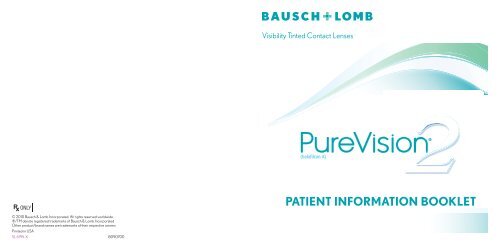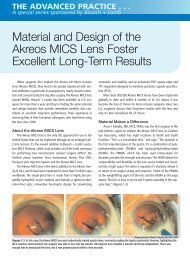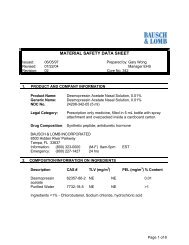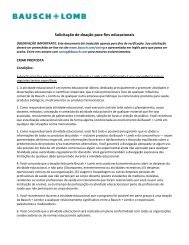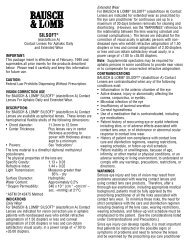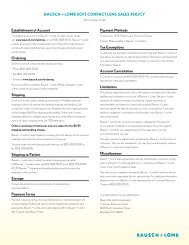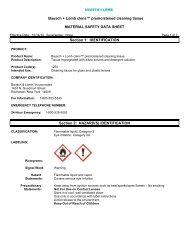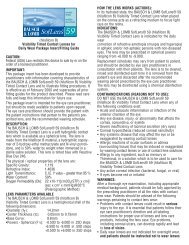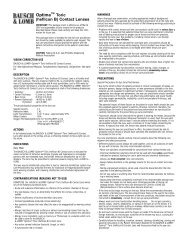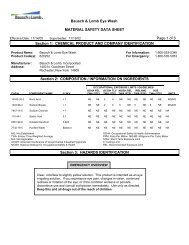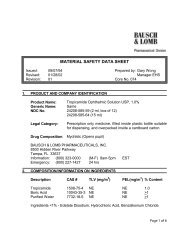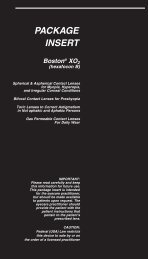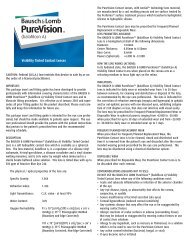Visibility Tinted Contact Lenses - Bausch + Lomb
Visibility Tinted Contact Lenses - Bausch + Lomb
Visibility Tinted Contact Lenses - Bausch + Lomb
You also want an ePaper? Increase the reach of your titles
YUMPU automatically turns print PDFs into web optimized ePapers that Google loves.
© 2010 <strong>Bausch</strong> & <strong>Lomb</strong> Incorporated. All rights reserved worldwide.<br />
®/TM denote registered trademarks of <strong>Bausch</strong> & <strong>Lomb</strong> Incorporated<br />
Other product/brand names are trademarks of their respective owners<br />
Printed in USA<br />
SL 6195-X 8090700<br />
<strong>Visibility</strong> <strong>Tinted</strong> <strong>Contact</strong> <strong>Lenses</strong><br />
PATIENT INFORMATION BOOKLET
Page<br />
Introduction 2<br />
Wearing Restrictions and Indications 3<br />
Contraindications (Reasons Not To Use) 4<br />
Warnings 5<br />
Precautions 5<br />
Adverse Reactions (Problems and What To Do) 8<br />
Personal Cleanliness and Lens Handling 8<br />
Preparing the Lens for Wearing 8<br />
Handling the <strong>Lenses</strong> 9<br />
Placing the Lens on the Eye 9<br />
Centering the Lens 11<br />
Removing the Lens 11<br />
Lens Wearing Schedules 11<br />
Caring for Your <strong>Lenses</strong> 12<br />
(Cleaning, Rinsing, Disinfecting, Enzyming,<br />
Storage and Rewetting/Lubricating) 12<br />
1<br />
Table of Contents<br />
Page<br />
Basic Instructions 12<br />
Chemical (Not Heat) Disinfection 13<br />
Lens Deposits and Use of Enzymatic<br />
Cleaning Procedure 14<br />
Lens Case Cleaning and Maintenance 14<br />
Care for a Sticking (Nonmoving) Lens 14<br />
Care for a Dried Out (Dehydrated) Lens 14<br />
Emergencies 14<br />
Lens Care Product Chart 15<br />
Instructions for the Monovision Wearer 16<br />
Personal Wearing Schedule Record 17<br />
Check-Up Visits 18<br />
Visit Schedule 18<br />
Eye Care Professional Information 19<br />
Glossary of Medical Terms 20<br />
Symbol Reference Guide 21
For labels and cartons:<br />
15˚ C /<br />
60 ˚ F<br />
25˚ C /<br />
80 ˚ F<br />
Quality System Certification Symbol<br />
Fee Paid for Waste Management<br />
Sterile Using Steam or Dry Heat<br />
See Instruction Leaflet<br />
Storage Temperature<br />
Diameter<br />
Use by Date (Expiration Date)<br />
Symbol Reference Guide<br />
Batch Code<br />
Authorised Representative<br />
in European Community<br />
Caution: Federal (U.S.A.) law restricts<br />
this device to sale by or on the order of<br />
a licensed practitioner.<br />
Diopter (Lens Power)<br />
Base Curve<br />
The instructions in this booklet apply to the<br />
<strong>Bausch</strong> + <strong>Lomb</strong> ® PureVision ® 2 (balafilcon A)<br />
<strong>Visibility</strong> <strong>Tinted</strong> <strong>Contact</strong> <strong>Lenses</strong>. If you have<br />
received or are considering another brand of<br />
contact lenses, do not use this booklet. Ask your<br />
eye care professional for the patient booklet or<br />
instructions that apply to your brand or type of<br />
contact lenses. For <strong>Bausch</strong> + <strong>Lomb</strong> ® PureVision ® 2<br />
<strong>Contact</strong> <strong>Lenses</strong>, it is essential to your safety that<br />
you read and understand the information and<br />
instructions in this booklet, and have your eye care<br />
professional answer any questions, both before<br />
and after you receive contact lenses.<br />
Wearing contact lenses is different from wearing<br />
eyeglasses. Because they are worn directly on<br />
your eyes, contact lenses affect the way in which<br />
your eyes function. These effects tend to increase<br />
with the length of time that the lenses remain on<br />
your eyes between removals. Although the great<br />
majority of people successfully wear contact<br />
lenses without problems, before you decide<br />
whether to begin or to continue wearing contact<br />
lenses for daily wear, you should discuss with your<br />
eye care professional the effects of contact lenses<br />
on your eyes and the risks associated with wearing<br />
contact lenses, which are greater with continuous<br />
wear contact lens use. You also should read<br />
the sections of this booklet entitled “Warnings”,<br />
Introduction<br />
“Adverse Reactions”, “Precautions”, and “Wearing<br />
Restrictions and Indications.” Ask your eye care<br />
professional to explain anything that you do not<br />
understand, including any additional restrictions<br />
which may be given to you by your eye care<br />
professional.<br />
You also need to remember that soft contact<br />
lenses, including those covered by this booklet,<br />
are made of a type of plastic that absorbs liquids,<br />
vapors, and small particles, and, for some<br />
people, may collect deposits from your natural<br />
eye fluids. Therefore, you should strictly follow<br />
the instructions contained in the sections of this<br />
booklet entitled “Personal Cleanliness and Lens<br />
Handling”, as well as the written information<br />
leaflets accompanying the lens care products that<br />
you buy and any other instructions given to you by<br />
your eye care professional. Any failure to follow<br />
these instructions and the wearing restrictions will<br />
increase the chances of contamination, damage to<br />
the lenses, or a build-up of deposits on the lenses,<br />
which can lead to serious, sight-threatening eye<br />
infections and injuries.<br />
Adherence to your prescribed wearing schedule<br />
and replacement schedule, and regular checkup<br />
visits to your eye care professional are also<br />
necessary for the proper and safe use of contact<br />
lenses.<br />
CAUTION: Federal (U.S.A.) law restricts this device to sale by or on the order of a licensed<br />
21<br />
practitioner.<br />
2
It is important to not wear your lenses<br />
longer than recommended by your eye care<br />
professional since doing so increases the risk<br />
of adverse effects.<br />
Spaces are provided in the back of this booklet for<br />
you to record your personal wearing schedule and<br />
schedule of follow-up visits. Soft contact lenses<br />
generally are comfortable from the beginning.<br />
Therefore, be sure to follow the wearing schedule<br />
prescribed for you, and do not wear your lenses<br />
for longer periods than your prescribed wearing<br />
schedule simply because they remain comfortable<br />
and you are not experiencing a problem. Only<br />
your eye care professional, through a professional<br />
VISION CORRECTION<br />
The <strong>Bausch</strong> + <strong>Lomb</strong> ® PureVision ® 2 (balafilcon A)<br />
<strong>Visibility</strong> <strong>Tinted</strong> <strong>Contact</strong> Lens is indicated for daily<br />
wear for the correction of refractive ametropia<br />
(myopia, hyperopia and astigmatism) in aphakic<br />
and/ornot-aphakicpersonswithnon-diseasedeyes,<br />
examination, can determine how your eyes are<br />
reacting to the contact lenses and whether there<br />
are any early signs of possible problems.<br />
Ifproblemsorsymptomsshouldoccur,immediately<br />
remove your lenses and follow the steps described<br />
in the section of this booklet entitled “Warnings”<br />
and “Adverse Reactions”. (Refer to “Glossary<br />
of Medical Terms” for description of medical<br />
terms used in this booklet). Prompt attention to<br />
problems is essential and may require immediate<br />
professional care.<br />
Remember, when wearing soft contact lenses your<br />
eyes should look and feel good, and your vision<br />
should be clear.<br />
Wearing Restrictions and Indications<br />
exhibiting astigmatism of 2.00 diopters or less, that<br />
doesnotinterferewithvisualacuity.Thelensmay be<br />
prescribed for Frequent/Planned Replacement or<br />
Disposable Wear in spherical powers ranging from<br />
+20.00D to -20.00D for daily wear.<br />
FREQUENT/PLANNED<br />
REPLACEMENT WEAR<br />
When prescribed for Frequent/Planned Replacement Wear, the <strong>Bausch</strong> + <strong>Lomb</strong> ® PureVision ® 2<br />
<strong>Contact</strong> Lens is to be cleaned, rinsed and disinfected each time it is removed from the patient’s eye<br />
and discarded after the recommended wearing period prescribed by the eye care professional. The<br />
lens may be disinfected using a chemical disinfection system.<br />
DISPOSABLE WEAR<br />
When prescribed for Disposable Wear, the <strong>Bausch</strong> + <strong>Lomb</strong> ® PureVision ® 2 <strong>Contact</strong> Lens is to be<br />
discarded after each removal.<br />
Glossary of Medical Terms<br />
Ametropia Abnormal vision requiring correction for proper focus<br />
Myopia Nearsighted<br />
Hyperopia Farsighted<br />
Aphakic Lacking a crystalline lens (focusing lens inside the eye)<br />
Non-aphakic Not lacking a crystalline lens<br />
Acute inflammation Sudden swelling, redness and pain<br />
Subacute inflammation Gradual swelling, redness and pain<br />
Anterior chamber Internal portion of the eye, between the cornea and iris<br />
Cornea Clear, front covering of the eye<br />
Conjunctiva Membrane that lines the eyelids and the white part of the eye<br />
Corneal ulcer A sore or lesion on the cornea, which left untreated could lead<br />
to permanent loss of vision<br />
Microbial keratitis An infected corneal ulcer<br />
Hypoxia Lack of oxygen<br />
Epithelial Layer of cells on the surface of the cornea<br />
Epithelial microcysts A small abnormal structure (cyst) in the front surface of the eye<br />
Endothelial polymegathism Irregular cell size and shape<br />
Neovascularization Small blood vessels growing into the cornea<br />
Iritis Internal inflammation of the colored part of the eye (iris)<br />
3 20
PLEASE FILL OuT FOR REAdy uSE<br />
Eye Care Professional Information<br />
Name: ______________________________________________________________________<br />
Address: ___________________________________________________________________<br />
Phone: _____________________________________________________________________<br />
Other Information: ___________________________________________________________<br />
____________________________________________________________________________<br />
____________________________________________________________________________<br />
____________________________________________________________________________<br />
IMPORTANT: In the event that you experience any difficulty wearing your lenses or you<br />
do not understand the instructions given to you, DO NOT WAIT for your next appointment.<br />
TELEPHONE YOUR EYE CARE PROFESSIONAL IMMEDIATELY.<br />
Name and Address of Manufacturer:<br />
<strong>Bausch</strong> & <strong>Lomb</strong> Incorporated<br />
Rochester, New York 14609<br />
Store lenses at room temperature (60°F – 80°F / 15°C – 25°C).<br />
WEARING RESTRICTIONS<br />
<strong>Bausch</strong> + <strong>Lomb</strong> ® PureVision ® 2 (balafilcon<br />
A) <strong>Visibility</strong> <strong>Tinted</strong> <strong>Contact</strong> <strong>Lenses</strong> described<br />
in this booklet should be removed from your<br />
eyes for routine cleaning and disinfecting as<br />
DO NOT USE <strong>Bausch</strong> + <strong>Lomb</strong> ® PureVision ® 2<br />
(balafilcon A) <strong>Visibility</strong> <strong>Tinted</strong> <strong>Contact</strong> <strong>Lenses</strong><br />
when any of the following conditions exist:<br />
• Acute and subacute inflammation or infection<br />
of the anterior chamber of the eye<br />
• Any eye disease, injury, or abnormality that<br />
affects the cornea, conjunctiva, or eyelids<br />
• Severe insufficiency of lacrimal secretion<br />
(dry eyes)<br />
• Corneal hypoesthesia (reduced corneal<br />
sensitivity)<br />
• Any systemic disease that may affect the eye or<br />
be exaggerated by wearing contact lenses<br />
prescribed by your eye care professional. Your<br />
eye care professional will tell you how long to<br />
rest your eyes in between wearing periods and<br />
will also recommend a replacement period and<br />
appropriate lens care products.<br />
Contraindications (Reasons Not To use)<br />
• Allergic reactions of ocular surfaces or adnexa<br />
(surrounding tissue) that may be induced or<br />
exaggerated by wearing contact lenses or use<br />
of contact lens solutions<br />
• Allergy to any ingredient, such as mercury or<br />
Thimerosal, in a solution which is to be used<br />
to care for <strong>Bausch</strong> + <strong>Lomb</strong> ® PureVision ® 2<br />
(balafilcon A) <strong>Visibility</strong> <strong>Tinted</strong> <strong>Contact</strong> <strong>Lenses</strong><br />
• Any active corneal infection (bacterial, fungal,<br />
or viral)<br />
• If eyes become red or irritated<br />
19 4
You should be aware of and fully discuss with<br />
your eye care professional the following warnings<br />
pertaining to contact lens wear:<br />
• Problems with contact lenses and lens care<br />
products could result in serious injury to<br />
your eye. It is essential that you follow your<br />
eye care professional’s direction and all<br />
labeling instructions for proper use of lenses<br />
and lens care products, including the lens case.<br />
Eye problems, including corneal ulcers, can<br />
develop rapidly and lead to loss of vision.<br />
• Strict compliance with your lens care regimen<br />
including cleaning of the lens case, wearing<br />
restrictions, wearing schedule, and follow-up<br />
visit schedule must be followed.<br />
Warnings<br />
Precautions<br />
• Daily wear lenses are not indicated for<br />
overnight wear, and you should not wear<br />
lenses while sleeping. Clinical studies have<br />
shown that the risk of serious adverse reactions<br />
is increased when contact lenses are worn<br />
overnight.<br />
• Studies have shown that contact lens wearers<br />
who are smokers have a higher incidence of<br />
adverse reactions than nonsmokers.<br />
• If you experience eye discomfort, excessive<br />
tearing, vision changes, or redness of the eye,<br />
you should immediately remove lenses and<br />
promptly contact your eye care professional.<br />
Check-up Visits<br />
Regular check-up examinations by your eye care professional are an important part of wearing<br />
contact lenses. It is recommended that you follow your eye care professional’s directions for follow<br />
up examinations. Keep all appointments for your check-up visits. If you move to a new city, ask<br />
your present eye care professional to refer you to a contact lens professional in your new location.<br />
Use the space below to record your appointments.<br />
VISIT SCHEduLE<br />
1. ____________________________________________________________________________<br />
Date Time<br />
2. ___________________________________________________________________________<br />
Date Time<br />
3. ___________________________________________________________________________<br />
Date Time<br />
4. ___________________________________________________________________________<br />
Date Time<br />
5. ___________________________________________________________________________<br />
Date Time<br />
You should be aware of and fully discuss with<br />
your eye care professional the following lens care<br />
regimen and safety precautions:<br />
SPECIFIC PRECAuTIONS:<br />
• Always discard disposable lenses and lenses<br />
worn on a frequent/planned replacement<br />
schedule after the recommended wearing<br />
schedule prescribed by the eye care<br />
professional.<br />
HANdLING PRECAuTIONS:<br />
• Always wash and rinse hands before handling<br />
lenses. Do not get cosmetics, lotions, soaps,<br />
creams, deodorants, or sprays in the eyes or<br />
on the lenses. It is best to put on lenses before<br />
putting on makeup. Waterbase cosmetics<br />
are less likely to damage lenses than oil-base<br />
products.<br />
• Before leaving your eye care professional’s<br />
6. __________________________________________________________________________<br />
Date Time<br />
7. ____________________________________________________________________________<br />
Date Time<br />
8. ___________________________________________________________________________<br />
Date Time<br />
9. ___________________________________________________________________________<br />
Date Time<br />
10. ___________________________________________________________________________<br />
5<br />
Date Time<br />
18
17<br />
Personal Wearing Record Schedule<br />
Your eye care professional will prescribe your own individual lens wearing schedule and lens replacement<br />
schedule. Use the space below to record your schedule and wearing record.<br />
DAY DATE HOURS TO BE WORN HOURS WORN<br />
1<br />
2<br />
3<br />
4<br />
5<br />
6<br />
7<br />
8<br />
9<br />
10<br />
11<br />
12<br />
13<br />
14<br />
15<br />
office be certain that you are able to remove<br />
your lenses promptly or have someone else<br />
available to remove them for you.<br />
• Be certain that the fingers or hands are free of<br />
foreign materials before touching your lenses, as<br />
microscopic scratches of the lenses may occur,<br />
causing distorted vision and/or injury to the eye.<br />
• Always handle your lenses carefully and avoid<br />
dropping them.<br />
• Do not touch the lens with your fingernails.<br />
• Carefully follow the handling, insertion, removal,<br />
cleaning, disinfecting, storing and wearing<br />
instructions in this booklet and those prescribed<br />
by your eye care professional.<br />
• Never use tweezers or other tools to remove<br />
your lenses from the lens container unless<br />
specifically indicated for that use. Pour the lens<br />
into the hand.<br />
SOLuTION PRECAuTIONS:<br />
• Do not use the Allergan Ultracare Disinfecting<br />
System or any of its components (Ultracare<br />
Disinfecting Solution, Ultracare Neutralizing<br />
Tablets, Lens Plus Daily Cleaner, and Ultrazyme<br />
Enzymatic Cleaner) to clean and disinfect<br />
<strong>Bausch</strong> + <strong>Lomb</strong> ® PureVision ® 2 (balafilcon A)<br />
<strong>Visibility</strong> <strong>Tinted</strong> <strong>Contact</strong> <strong>Lenses</strong> because the lens<br />
dimensions will be altered.<br />
* Note: Eye injury due to irritation or infection may<br />
result from lens contamination. To reduce the risk of<br />
contamination, review the appropriate manufacturer’s<br />
labeled lens care instructions with the patient.<br />
• Always use fresh unexpired lens care solutions.<br />
• Always follow directions in the package inserts<br />
for the use of contact lens solutions.<br />
• Sterile unpreserved solutions, when used,<br />
should be discarded after the time specified in<br />
the labeling directions.<br />
• Always keep the lenses completely immersed<br />
in the recommended storage solution when<br />
lenses are not being worn (stored). Prolonged<br />
periods of drying will damage lenses. Follow the<br />
lens care directions for Care for a Dried Out<br />
(Dehydrated) Lens if lens surface does become<br />
dried out.<br />
• Do not use saliva or anything other than the<br />
recommended solution for lubricating or<br />
wetting lenses.<br />
• Tap water, distilled water or homemade saline<br />
should not be used as a substitute for any.<br />
component in the lens care regimen since they<br />
have been associated with an Acanthamoeba<br />
keratitis infection.<br />
• Never use conventional hard contact lens<br />
solutions that are not also recommended for use<br />
with prescribed lenses.<br />
• Do not mix or alternate lens care systems or<br />
solutions unless indicated in the lens care system<br />
labeling.<br />
• Do not heat the chemical disinfection<br />
solution or lenses.<br />
LENS WEARING PRECAuTIONS:<br />
• Never wear your lenses beyond the period<br />
recommended by your eye care professional.<br />
• If the lens sticks (stops moving) on the eye,<br />
follow the recommended directions on<br />
6
Care for a Sticking (Nonmoving) Lens. The<br />
lens should move freely on the eye for the<br />
continued health of the eye. If nonmovement<br />
of the lens continues, you should immediately<br />
consult your eye care professional.<br />
• Avoid, if possible, all harmful or irritating vapors<br />
and fumes when wearing lenses.<br />
• If aerosol products are used while wearing<br />
lenses, exercise caution and keep eyes closed<br />
until the spray has settled.<br />
LENS CASE PRECAuTIONS:<br />
• <strong>Contact</strong> lens cases can be a source of bacterial<br />
growth. To prevent contamination and to help<br />
avoid serious eye injury, always empty and rinse<br />
the lens case with fresh, sterile rinsing solution<br />
and allow to air dry.<br />
• Lens cases should be replaced at monthly<br />
intervals as recommended by the lens case<br />
manufacturer or eye care professional.<br />
TOPICS TO dISCuSS WITH THE EyE<br />
CARE PROFESSIONAL:<br />
• As with any contact lens, follow-up visits are<br />
necessary to assure the continuing health<br />
of the eyes. You should be instructed as to a<br />
recommended follow-up schedule.<br />
• Patients should be advised about wearing<br />
lenses during sporting and water related<br />
activities. Exposure to water while<br />
wearing contact lenses in activities such as<br />
swimming, water skiing and hot tubs may<br />
increase the risk of ocular infection including<br />
but not limited to Acanthamoeba keratitis.<br />
• Always contact your eye care professional<br />
before using any medicine in the eyes.<br />
WHO SHOuLd KNOW THAT THE<br />
PATIENT IS WEARING CONTACT LENSES:<br />
• Inform your doctor (health care professional)<br />
about being a contact lens wearer.<br />
• Alwaysinformyouremployerofbeingacontact<br />
lens wearer. Some jobs may require the use of<br />
eye protection equipment or may require that<br />
you not wear lenses.<br />
Ask your eye care professional whether there are<br />
any other wearing restrictions that apply to you.<br />
Write those restrictions in the spaces provided<br />
below and follow them carefully:<br />
____________________________________<br />
____________________________________<br />
____________________________________<br />
____________________________________<br />
Instructions for the Monovision Wearer<br />
• You should be aware that as with any type of<br />
lens correction, there are advantages and<br />
disadvantages to monovision contact lens<br />
therapy. The benefit of clear near vision in<br />
straight ahead and upward gaze that is available<br />
with monovision may be accompanied by a<br />
vision compromise that may reduce your visual<br />
acuity and depth perception for distance and<br />
near tasks.<br />
• Some patients have experienced difficulty<br />
adapting to monovision contact lens therapy.<br />
Symptoms, such as mild blurred vision,<br />
dizziness, headaches and a feeling of slight<br />
imbalance, may last for a brief minute or for<br />
several weeks as adaptation takes place. The<br />
longer these symptoms persist, the poorer your<br />
prognosis for successful adaptation.<br />
• You should avoid visually demanding situations<br />
during the initial adaptation period. It is<br />
recommended that you first wear these<br />
contact lenses in familiar situations, which are<br />
not visually demanding. For example, it might<br />
be better to be a passenger rather than a driver<br />
of an automobile during the first few days of lens<br />
wear.Itisrecommendedthatyou onlydrive with<br />
monovision correction if you pass your state<br />
drivers license requirements with monovision<br />
correction.<br />
• Some monovision patients will never be fully<br />
comfortable functioning under low levels<br />
of illumination, such as driving at night. If<br />
this happens, you may want to discuss with<br />
your eye care professional having additional<br />
contact lenses prescribed so that both eyes<br />
are corrected for distance when sharp distance<br />
binocular vision is required.<br />
• If you require very sharp near vision during<br />
prolonged close work, you may want to have<br />
additional contact lenses prescribed so that<br />
both eyes are corrected for near when sharp<br />
near binocular vision is required.<br />
• Some monovision patients require<br />
supplemental spectacles to wear over the<br />
monovision correction to provide the clearest<br />
vision for critical tasks. You should discuss this<br />
option with your eye care professional.<br />
• It is important that you follow your eye care<br />
professional’s suggestions for adaptation to<br />
monovision contact lens therapy. You should<br />
discuss any concerns that you may have during<br />
and after the adaptation period.<br />
• The decision to be fit with a monovision<br />
correction is most appropriately left to the<br />
eye care professional in conjunction with<br />
you, after carefully considering and<br />
discussing your needs.<br />
7 16
15<br />
Lens Care Product Chart<br />
The following solutions are available from <strong>Bausch</strong> + <strong>Lomb</strong> for use with all <strong>Bausch</strong> + <strong>Lomb</strong> <strong>Contact</strong> <strong>Lenses</strong>;<br />
however, eye care professionals may recommend alternative products and procedures which should be<br />
followed by the patient. <strong>Bausch</strong> + <strong>Lomb</strong> ® Care Kits are available for lens disinfection, cleaning and storage.<br />
CHEMICAL LENS CARE SySTEMS<br />
ACTION CARE PRODUCT<br />
Cleaning <strong>Bausch</strong> + <strong>Lomb</strong> ® renu ® fresh TM multi-purpose solution<br />
<strong>Bausch</strong> + <strong>Lomb</strong> ® renu ® sensitive TM multi-purpose solution<br />
<strong>Bausch</strong> & <strong>Lomb</strong> ® Sensitive Eyes ® Daily Cleaner<br />
<strong>Bausch</strong> + <strong>Lomb</strong> ® Biotrue TM multi-purpose solution<br />
Disinfecting & Storing <strong>Bausch</strong> + <strong>Lomb</strong> ® renu ® fresh TM multi-purpose solution<br />
<strong>Bausch</strong> + <strong>Lomb</strong> ® renu ® sensitive TM multi-purpose solution<br />
<strong>Bausch</strong> + <strong>Lomb</strong> ® Biotrue TM multi-purpose solution<br />
Rinsing <strong>Bausch</strong> + <strong>Lomb</strong> ® renu ® fresh TM multi-purpose solution<br />
<strong>Bausch</strong> + <strong>Lomb</strong> ® renu ® sensitive TM multi-purpose solution<br />
<strong>Bausch</strong> & <strong>Lomb</strong> ® Sensitive Eyes ® Saline Solution<br />
<strong>Bausch</strong> & <strong>Lomb</strong> ® Sensitive Eyes ® Plus Saline Solution<br />
<strong>Bausch</strong> + <strong>Lomb</strong> ® Biotrue TM multi-purpose solution<br />
Enzymatic Protein Removal <strong>Bausch</strong> & <strong>Lomb</strong> ® ReNu ® 1 Step TM Daily Protein Remover Liquid<br />
Rewetting <strong>Bausch</strong> & <strong>Lomb</strong> ® ReNu MultiPlus ® Lubricating and Rewetting Drops<br />
<strong>Bausch</strong> & <strong>Lomb</strong> ® ReNu ® Rewetting Drops<br />
• Note: Some solutions may perform more than one function in the care regimen, which will be indicated on the label.<br />
Read the label on the solution bottle, and follow instructions.<br />
Adverse Reactions (Problems And What To do)<br />
yOu SHOuLd BE AWARE THAT THE<br />
FOLLOWING PROBLEMS MAy OCCuR:<br />
• Eyes stinging, burning, itching (irritation),<br />
or other eye pain<br />
• Comfort is less than when lens was first placed<br />
on eye<br />
• Abnormal feeling of something in the eye<br />
(foreign body, scratched area)<br />
• Excessive watering (tearing) of the eyes<br />
• Unusual eye secretions<br />
• Redness of the eyes<br />
• Reduced sharpness of vision (poor visual acuity)<br />
• Blurred vision, rainbows, or halos<br />
around objects<br />
• Sensitivity to light (photophobia)<br />
• Dry eyes<br />
IF yOu NOTICE ANy OF THE ABOVE,<br />
yOu SHOuLd:<br />
• Immediately remove your lenses.<br />
1. PREPARING THE LENS FOR WEARING<br />
It is essential that you learn and use good hygienic<br />
methods in the care and handling of your new<br />
lenses. Cleanliness is the first and most important<br />
aspect of proper contact lens care. In particular,<br />
• If the discomfort or problem stops, then look<br />
closely at the lens. If the lens is in any way<br />
damaged, do not put the lens back on your<br />
eye. Place the lens in the storage case and<br />
contact your eye care professional. If the lens<br />
has dirt, an eyelash, or other foreign body on<br />
it, or the problem stops and the lens appears<br />
undamaged,youshouldthoroughlyclean,rinse,<br />
and disinfect the lenses; then reinsert them.<br />
After reinsertion, if the problem continues, you<br />
should immediately remove the lenses<br />
and consult your eye care professional.<br />
When any of the above problems occur, a<br />
serious condition such as infection, corneal ulcer,<br />
neovascularization, or iritis may be present. You<br />
should keep the lens off your eye and seek<br />
immediate professional identification of the<br />
problem and prompt treatment to avoid serious<br />
eye damage.<br />
Personal Cleanliness and Lens Handling<br />
your hands should be clean and free of any foreign<br />
substances when you handle your lenses. The<br />
procedures are:<br />
• Always wash your hands thoroughly with<br />
a mild soap, rinse completely, and dry with a lint-<br />
8
free towel before touching your lenses.<br />
from <strong>Bausch</strong> + <strong>Lomb</strong>.) Then GENTLY rub the<br />
A thorough rinse in fresh sterile saline solution could damage your eye. If the lens does not begin to<br />
• Avoid the use of soaps containing cold cream,<br />
lotion, or oily cosmetics before handling your<br />
lenses, since these substances may come<br />
into contact with the lenses and interfere with<br />
successful wearing.<br />
• Handle your lenses with your fingertips, and<br />
be careful to avoid contact with fingernails. It<br />
is helpful to keep your fingernails short and<br />
smooth.<br />
Start off correctly by getting into the habit of always<br />
using proper hygienic procedures so that they<br />
become automatic.<br />
•<br />
•<br />
lens between your index finger and palm in<br />
a gentle back and forth motion.<br />
If this gentle rubbing does not work, soak the lens<br />
in the recommended solution in your lens case<br />
until the lens has resumed its normal shape. If the<br />
lens flattens or drapes across your finger, the lens<br />
or your finger may be too wet. To correct this, dry<br />
your finger by transferring the lens several times<br />
from one index finger to the other, drying the<br />
opposite finger each time.<br />
Keep the lens wet in the solution recommended<br />
by your eye care professional.<br />
prior to placement on your eye should reduce<br />
the potential for irritation.<br />
3. LENS dEPOSITS ANd uSE OF<br />
ENzyMATIC CLEANING PROCEduRE<br />
Enzyme cleaning may be recommended by your<br />
eye care professional. Enzyme cleaning removes<br />
protein deposits on the lens. These deposits cannot<br />
be removed with regular cleaners. Removing<br />
protein deposits is important for the well-being<br />
of your lenses and eyes. If these deposits are not<br />
removed, they can damage the lenses and cause<br />
irritation.<br />
move when you blink after several applications of the<br />
solution or drops, contact your eye care professional<br />
immediately. Do not attempt to remove the lens<br />
except on the advice of your eye care professional.<br />
6. CARE FOR A dRIEd OuT<br />
(dEHydRATEd) LENS<br />
If a soft, hydrophilic contact lens is exposed to air<br />
while off the eye, it may become dry and brittle and<br />
need to be rehydrated. If the lens is adhering to a<br />
surface, apply the recommended rinsing solution<br />
before handling.<br />
To rehydrate the lens:<br />
2. HANdLING THE LENSES<br />
• Develop the habit of always working with the<br />
same lens first to avoid mixups.<br />
• Remove the lens from its storage case and<br />
examine it to be sure that it is moist, clean, clear,<br />
and free of any nicks or tears.<br />
• Should you accidentally place an inside-out lens<br />
on your eye, one of the following signs should<br />
signal you to remove and replace it correctly.<br />
a. Less than usual comfort<br />
b. The lens may fold on the eye<br />
• Never place a lens on the eye unless it has been<br />
fully hydrated (wet) with the recommended<br />
rinsing or storing solution. (Refer to the Lens<br />
Care Products Chart for the solutions available<br />
from <strong>Bausch</strong> + <strong>Lomb</strong>.)<br />
3. PLACING THE LENS ON THE EyE<br />
There are other methods of lens placement. If the<br />
following methods are difficult for you, your eye<br />
care professional will provide you with an alternate<br />
method.<br />
* Note: If after placement of the lens, your vision is blurred, check<br />
for the following:<br />
Enzyme cleaning does NOT replace routine<br />
cleaning and disinfecting. For enzyme cleaning,<br />
you should carefully follow the instructions in the<br />
enzymatic cleaning labeling.<br />
4. LENS CASE CLEANING ANd<br />
MAINTENANCE<br />
<strong>Contact</strong> lens cases can be a source of bacteria<br />
growth. Lens cases should be emptied, cleaned,<br />
rinsed with solutions recommended by the lens<br />
case manufacturer, and allowed to air dry each time<br />
you remove the contact lenses from it. Lens cases<br />
should be replaced at monthly intervals.<br />
• Handle the lens carefully.<br />
• Place the lens in its storage case and soak the<br />
lens in a recommended rinsing and storing<br />
solution for at least 1 hour until it returns to a soft<br />
state.<br />
• Clean lens first, then disinfect the rehydrated<br />
lens using a recommended lens care system.<br />
• If after soaking, the lens does not become soft<br />
or if the surface remains dry, DO NOT USE<br />
THE LENS UNTIL IT HAS BEEN EXAMINED<br />
BY YOUR EYE CARE PROFESSIONAL.<br />
c. Excessive lens movement on blink<br />
d. Blurred vision<br />
• If the lens folds and sticks together: Place<br />
the lens in the palm of your hand and wet<br />
thoroughly with the recommended rinsing<br />
or storing solution. (Refer to the Lens Care<br />
Products Chart for the solutions available<br />
9<br />
• The lens is not centered on the eye (see<br />
“Centering the Lens,” next in this booklet).<br />
• If the lens is centered, remove the lens (see<br />
“Removing the Lens” section) and check for the<br />
following:<br />
a. Cosmetics or oils on the lens. Clean, rinse,<br />
disinfect, and place on the eye again.<br />
5. CARE FOR A STICKING<br />
(NONMOVING) LENS<br />
It is important to the health of your eyes that your<br />
contact lenses move freely. If a lens sticks (stops<br />
moving), put a few drops of the lubricating or<br />
rewetting solution recommended by your eye care<br />
professional into your eye. Do not use plain water or<br />
anything other than the recommended solutions. Do<br />
not attempt to remove a lens that is sticking, which<br />
7. EMERGENCIES<br />
If chemicals of any kind (household products,<br />
gardening solutions, laboratory chemicals, etc.) are<br />
splashed into your eyes, you should:<br />
FLUSH EYES IMMEDIATELY WITH TAP<br />
WATER AND THEN REMOVE LENSES<br />
PROMPTLY. CONTACT YOUR EYE CARE<br />
PROFESSIONAL OR VISIT A HOSPITAL<br />
EMERGENCY ROOM WITHOUT DELAY.<br />
14
program should be thrown away after the<br />
expiration of the wearing period prescribed by<br />
your eye care professional.<br />
• Never rinse your lenses in water from the tap.<br />
There are two reasons for this:<br />
a. Tap water contains many impurities that can<br />
contaminate or damage your lenses and may<br />
lead to eye infection or injury.<br />
b. You might lose the lens down the drain.<br />
• Clean one lens first (always the same lens first<br />
to avoid mix-ups), rinse the lens thoroughly with<br />
recommended saline or disinfecting solution to<br />
remove the cleaning solution, mucus, and film<br />
from the lens surface. Follow the instructions<br />
provided in the cleaning solution labeling. Put<br />
that lens into the correct chamber of the lens<br />
storage case. Then repeat the procedure for the<br />
second lens.<br />
• After cleaning, and rinsing, disinfect lenses<br />
using the system recommended by your eye<br />
care professional. Follow the instructions<br />
provided in the disinfection solution labeling.<br />
• To store lenses, disinfect and leave them in the<br />
closed/unopenedcaseuntilreadytowear.Iflenses<br />
are not to be used immediately after disinfection,<br />
you should consult the labeling of the storage<br />
solution for information on lens storage.<br />
• After removing your lenses from the lens case,<br />
empty and rinse the lens storage case with<br />
solution(s) recommended by the lens case<br />
manufacturer; then allow the lens case to air dry.<br />
When the case is used again, refill it with fresh<br />
storage solution. Replace lens case at monthly<br />
intervals.<br />
• Your eye care professional may recommend<br />
a lubricating/rewetting solution for your use.<br />
Lubricating/Rewetting solutions can be used<br />
to wet (lubricate) your lenses while you are<br />
wearing them to make them more comfortable.<br />
2. CHEMICAL (NOT HEAT)<br />
dISINFECTION<br />
• Clean the contact lenses with the cleaning<br />
solution recommended by your eye care<br />
professional and thoroughly rinse them with the<br />
recommended rinsing solution.<br />
• After cleaning, and rinsing, to disinfect,<br />
carefully follow the instructions accompanying<br />
the disinfecting solution in the care regimen<br />
recommended by your eye care professional.<br />
• When using hydrogen peroxide lens care<br />
systems, lenses must be neutralized before<br />
wearing. Follow the recommendations on the<br />
hydrogen peroxide system labeling.<br />
• Thoroughly rinse lenses with a fresh s olution<br />
recommended for rinsing before inserting<br />
and wearing, or follow the instructions on the<br />
disinfection solution labeling.<br />
• Do not heat the disinfection solution and<br />
lenses.<br />
• Leave the lenses in the closed storage case until<br />
ready to put on your eyes.<br />
• Caution: <strong>Lenses</strong> that are chemically disinfected<br />
may absorb ingredients from the disinfecting<br />
solution which may be irritating to your eyes.<br />
b. The lens is on the wrong eye.<br />
c. The lens is inside-out (it would also not be as<br />
comfortable as normal).<br />
If you find that your vision is still blurred after<br />
checking the above possibilities, remove both<br />
lenses and consult your eye care professional.<br />
THE ONE HAND PLACEMENT TECHNIQUE<br />
Place the lens on your index finger. With your<br />
head up, looking straight ahead, pull down<br />
your lower eyelid with the middle finger of your<br />
placement hand. Look up steadily at a point above<br />
you. Then place the lens on the lower white part<br />
of your eye. Remove your index finger and slowly<br />
release the lower lid. Look down to position the lens<br />
properly. Close your eyes for a moment: the lens will<br />
center itself on your eye.<br />
THE TWO HAND PLACEMENT TECHNIQUE<br />
With the lens on your index finger, use the middle<br />
finger of the other hand to pull the upper lid against<br />
the brow. Use the middle finger of your placement<br />
hand to pull down the lower lid and then place<br />
the lens centrally on your eye. While holding<br />
this position, look downward to position the lens<br />
properly. Slowly release your eyelids.<br />
If the Lens Feels Uncomfortable, then:<br />
Look in a mirror and gently place a finger on<br />
the edge of the contact lens and slowly slide the lens<br />
away from your nose while looking in the opposite<br />
direction. Then by blinking, the lens will recenter<br />
itself. If the lens still feels uncomfortable, follow<br />
the steps described in the section of this booklet<br />
entitled “Adverse Reactions.”<br />
13 10
4. CENTERING THE LENS<br />
Very rarely, a lens that is on the cornea will<br />
be displaced onto the white part of the eye<br />
during lens wear. This can also occur during<br />
placement and removal of the lenses if the<br />
correct techniques are not performed properly. To<br />
center a lens follow one of the procedures below.<br />
• Hold the upper and lower eyelids open with your<br />
fingers. Then, while looking in a mirror, gently<br />
placeafingeronthecontactlensandgentlyslide<br />
the lens towards the center of the eye.<br />
Or<br />
• Hold the upper and lower eyelids open with<br />
your fingers. Then, while looking in a mirror,<br />
move your eye towards the lens to place it on<br />
the center of the eye.<br />
5. REMOVING THE LENS<br />
Always remove the same lens first.<br />
a. Wash, rinse, and dry your hands thoroughly.<br />
b. Always be sure that the lens is in the<br />
correct position on your eye before you try<br />
to remove it (a simple check of your vision,<br />
closing one eye at a time, will tell you if the<br />
lens is in the correct position). Look up and<br />
slowly pull down your lower lid with the<br />
middle finger of your removal hand and place<br />
your index finger on the lower edge of the<br />
lens. Squeeze the lens lightly between the<br />
thumb and index finger and remove it. Avoid<br />
sticking the edges of the lens together.<br />
c. Remove the other lens by following the same<br />
procedure.<br />
d. Follow the required lens care procedures<br />
describedundertheheading,CARINGFOR<br />
YOUR LENSES (CLEANING, RINSING,<br />
DISINFECTING, ENZYMING, STORAGE<br />
AND REWETTING/LUBRICATING)<br />
* Note: If this method of removing your lens is difficult for you, your<br />
eye care professional will provide you with an alternate method.<br />
LENS WEARING SCHEduLES<br />
Your eye care professional may either recommend<br />
using the <strong>Bausch</strong> + <strong>Lomb</strong> ® PureVision ® 2<br />
(balafilcon A) <strong>Visibility</strong> <strong>Tinted</strong> <strong>Contact</strong> <strong>Lenses</strong> as a<br />
disposablelensorafrequent/plannedreplacement<br />
lens.<br />
Regardless of the schedule prescribed for<br />
you, once a lens is removed at the end of the<br />
prescribed wearing period, your eye should<br />
have a rest period with no lens wear of<br />
overnight or longer, as recommended by your<br />
eye care professional.<br />
dISPOSABLE LENS WEAR:<br />
No lens care is needed. The lenses are discarded<br />
every time they are removed from the eye. <strong>Lenses</strong><br />
should only be cleaned, rinsed and disinfected on<br />
an emergency basis when replacement lenses are<br />
not available<br />
FREquENT/PLANNEd REPLACEMENT:<br />
When removed between replacement periods,<br />
lenses must be cleaned and disinfected before<br />
reinsertion, or be discarded and replaced with a<br />
new lens.<br />
Caring for your <strong>Lenses</strong><br />
(Cleaning, Rinsing, disinfecting,Enzyming, Storage and Rewetting/Lubricating)<br />
1. BASIC INSTRuCTIONS<br />
For continued safe and comfortable wearing of<br />
your lenses, it is important that you first clean and<br />
rinse, then disinfect[andneutralize(forhydrogen<br />
peroxide systems)] your lenses after each removal,<br />
using the lens care regimen recommended by<br />
your eye care professional. Cleaning and rinsing<br />
are necessary to remove mucus, secretions, films,<br />
or deposits which may have accumulated during<br />
wearing. The ideal time to clean your lenses is<br />
immediately after removing them. Disinfecting is<br />
necessary to destroy harmful germs.<br />
You should adhere to the lens care regimen<br />
recommended by your eye care professional.<br />
Failure to follow the lens care regimen may result<br />
in development of serious ocular complications as<br />
discussed in the WARNINGS section above.<br />
If you require only vision correction, but will not<br />
or cannot adhere to a recommended lens care<br />
regimen, or are unable to place and remove lenses<br />
or have someone available to place and remove<br />
them, you should not attempt to get and wear<br />
contact lenses.<br />
When you first get your lenses, be sure to practice<br />
putting on your lenses and removing them while<br />
you are in your eye care professional’s office. At<br />
thattimeyouwillbeprovidedwitharecommended<br />
cleaning and disinfection regimen and instructions<br />
and warnings for lens care, handling, cleaning, and<br />
disinfection. Your eye care professional should<br />
instruct you about appropriate and adequate<br />
procedures and products for your use, and provide<br />
you with a copy of these Patient Instructions for<br />
<strong>Bausch</strong> + <strong>Lomb</strong> ® PureVision ® 2 (balafilcon A)<br />
<strong>Visibility</strong> <strong>Tinted</strong> <strong>Contact</strong> <strong>Lenses</strong>.<br />
For safe contact lens wear, you should know and<br />
always practice your lens care routine:<br />
• Always wash, rinse, and dry hands before<br />
handling contact lenses.<br />
• Always use fresh unexpired lens care<br />
solutions.<br />
• Use the recommended chemical (not<br />
heat) lens care system and carefully follow<br />
instructions on solution labeling. Different<br />
solutions cannot always be used together,<br />
and not all solutions are safe for use with<br />
all lenses. Do not alternate or mix lens<br />
care systems unless indicated on<br />
solution labeling.<br />
• Always remove, clean, rinse, enzyme and<br />
disinfect your lenses according to the schedule<br />
prescribed by your eye care professional. The<br />
use of an enzyme or any cleaning solution does<br />
not substitute for disinfection.<br />
• Do not use saliva or anything other than the<br />
recommended solutions for lubricating or<br />
rewetting your lenses. Do not put lenses in your<br />
mouth.<br />
• <strong>Lenses</strong> prescribed in a frequent replacement<br />
11 12


